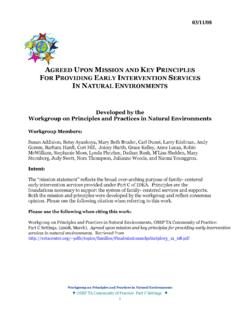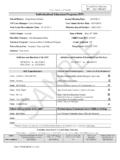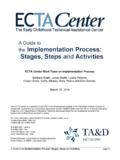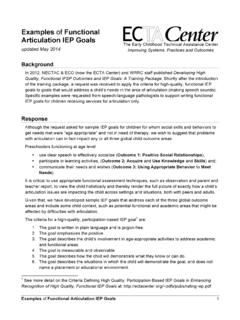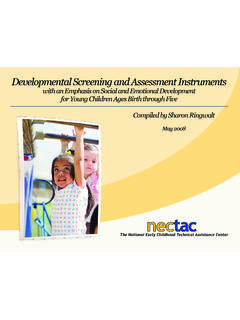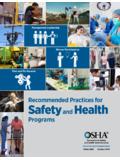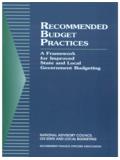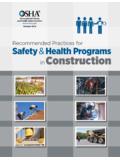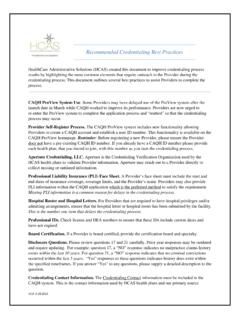Transcription of Reaching Potentials through Recommended Practices ...
1 Reaching Potentials through Recommended Practices observation scale Classrooms (RP OS-C) Phillip S. Strain, Edward Bovey, and Lise Fox Early Childhood Technical Assistance Center (ECTA Center) February, 2015 Copyright 2015 The ECTA Center is a program of the FPG Child Development Institute of the University of North Carolina at Chapel Hill, funded through cooperative agreement number H326P120002 from the Office of Special Education Programs, Department of Education. Opinions expressed herein do not necessarily represent the Department of Education's position or policy. Project Officer: Julia Martin Eile RP2 OS-C Page 2 Reaching Potentials through Recommended Practices observation scale Classrooms (RP OS-C) Procedure for Scoring Recommended Practice Items via observation It is Recommended that observers devote the equivalent of a full day observation to each classroom of interest, understanding that a full day for some classrooms could be a day.
2 The RP -OS is designed to measure the delivery of RP ( Recommended Practices ) to children who might need specialized instructional strategies and supports to promote their engagement in learning. Thus, the focus of observation should be on all the adults who are providing intervention as the lead teacher is responsible for ensuring that RPs are used to support individual children in the classroom . As you observe make notes in the comment section about specific adults and specific instances of Practices used and/or opportunities missed in order to have a good set of reminders at the end of observation . Only at the end of the day complete the ratings. Procedure for Scoring Recommended Practice Items via INTERVIEW The Recommended Practice items identified as Interview below are difficult if not impossible to observe directly. Therefore, for each of these items we recommend that the coach conduct an interview with the lead teacher in target classrooms.
3 Interviewers should feel free to use as many questions and requests for clarification as needed to feel comfortable in rating each item. To help focus the interview we suggest that the interviewer and interviewee agree on a specific child and/or family of concern when addressing specific questions. So, for example, the interviewer might ask, Can you tell me about your contact with Billy s family in the process of completing the IEP/IFSP? Or, Let s talk about Hector for a moment, how is it that you chose the particular assistive device? For these items you may also want to ask for a permanent product that supports the interviewee s comments. Using the Ratings Ratings should represent the modal or most typical set of events you saw for a particular item. It will not be unusual to see practitioners implementing with varying degrees of precision across the day.
4 When that happens, pick the rating that would best represent what you saw most often. Below are some general guidelines for rating categories. You will notice that the vast majority of Practices have multiple indicators. The scoring rubric reflects these multiple indicators and you will have only one score for a practice. 5. All Indicators Seen or Reported Across All Relevant Routines and Environments: This rating is reserved for observations where practitioners implemented the practice precisely on each and every occasion and they utilized the practice across all activities and routines. 4. Two or Three Indicators Seen or Reported Across Most But Not All Routines 3. One or Two Indicators Seen or Reported Sporadically: This rating represents situations where there was variability in the quality of use across opportunities or the practitioners simply missed numerous opportunities to use the practice.
5 2. One Indicator Seen or Reported but Many Opportunities Missed 1. No Indicators Seen or Reported: This rating is reserved for situations where you see no or poor implementation of the practice or the practice is underutilized across available opportunities. RP2 OS-C Page 3 ENVIRONMENT Practices Items All indicators seen or reported Two or three indicators seen or reported across most but not all routines One or two indicators seen or reported sporadically One indicator seen or reported but many opportunities missed No indicators seen or reported 1. Practitioners work with the family and other adults to modify and adapt the physical, social, and temporal environments to promote each child s access to and participation in learning experiences. (E3)1 INTERVIEW Practitioners identify the potential physical, social, and temporal environments that interfere with child s participation in classroom activities and engagement with peers and materials.
6 Practitioners collaborate with family and other adults to determine adaptations that increase child s participation in classroom activities and engagement with peers and materials. Practitioners implement adaptations to promote child s access and participation in learning experiences and reduces or eliminates the adaptations as children become more independent. 5 4 3 2 1 2. Practitioners work with families and other adults to identify each child s needs for assistive technology to promote access to and participation in learning experiences. (E4) INTERVIEW Practitioners identify challenges in child participation in learning experiences that might be resolved through the use of assistive technology (AT). Practitioners collaborate with family and other adults to determine AT that matches the child s strengths, interests, and preferences and can be easily used within everyday environments and interactions.
7 Practitioners collaborate with family and other adults to select AT that might be best suited to the child s needs, strengths, and the nature of the learning activities. 5 4 3 2 1 3. Practitioners work with families and other adults to acquire or create appropriate assistive technology to promote each child s access to and participation in learning experiences. (E5) INTERVIEW Practitioners identify resources to create or access AT that will promote the child s participation in learning experiences. When necessary, practitioners engage in advocacy to support child and family in gaining AT that is necessary to promote the child s access to and participation in learning experiences. Practitioners implement AT supports within everyday routines and fade the use of AT supports as children become more independent. 5 4 3 2 1 1 Letter and number following practice indicates the letter and number of the selected DEC Recommended Practice, E3 is DEC Recommended Practice #3 in Environmental Practices .
8 RP2 OS-C Page 4 Interview Questions for the Environment Indicators (These questions are offered as suggestions. Ask any and as many questions as needed to assess the indicators): I see that you are using some special equipment so that child s name can participate in circle. Can you describe the process that was used to figure out what supports you might use? Child s name seems to really struggle with participating in centers. He seems to be on a developmental level that makes it challenging to join other children to play. When you have that kind of situation in the classroom , what do you do to help the child participate? All the children were really engaged in activities. If you were to have a child who struggled to participate, what process would you use to make sure the child could be engaged in learning opportunities? Comments: RP2 OS-C Page 5 FAMILY Practices Items All indicators seen or reported Two or three indicators seen or reported across most but not all routines One or two indicators seen or reported sporadically One indicator seen or reported but many opportunities missed No indicators seen or reported 4.
9 Practitioners build trusting and respectful partnerships with the family through interactions that are sensitive and responsive to cultural, linguistic, and socio-economic diversity. (F1) INTERVIEW Practitioners engage the family in respectful conversation. Practitioners value the family s responses about their interests, concerns and beliefs in order to better understand what the family values in relation to what and how their child learns. Practitioners are nonjudgmental about family choices and decisions. 5 4 3 2 1 5. Practitioners are responsive to the family s concerns, priorities, and changing life circumstances. (F3) INTERVIEW Practitioners engage the family in discussions of their concerns and priorities including their expectations and aspirations for the child. Practitioners collaborate with the family to identify the activities, supports, and resources that will be most helpful in achieving their expectations and aspirations for their child.
10 Practitioners are flexible and supportive when the family s concerns or priorities for the child change. 5 4 3 2 1 6. Practitioners and the family work together to create outcomes or goals, develop individualized plans, and implement Practices that address the family s priorities and concerns and the child s strengths and needs. (F4) INTERVIEW Practitioners discuss with the family which of their everyday activities, routines or opportunities they think the family could use to promote the child s learning outcomes or goals for child s learning. Practitioners and family observe the child in multiple contexts to identify the child s interests, strengths, and challenges in learning activities in order to develop plans/goals and learning activities. Practitioners help the family identify and use learning activities that address the family s priorities and concerns and the child s strengths.


